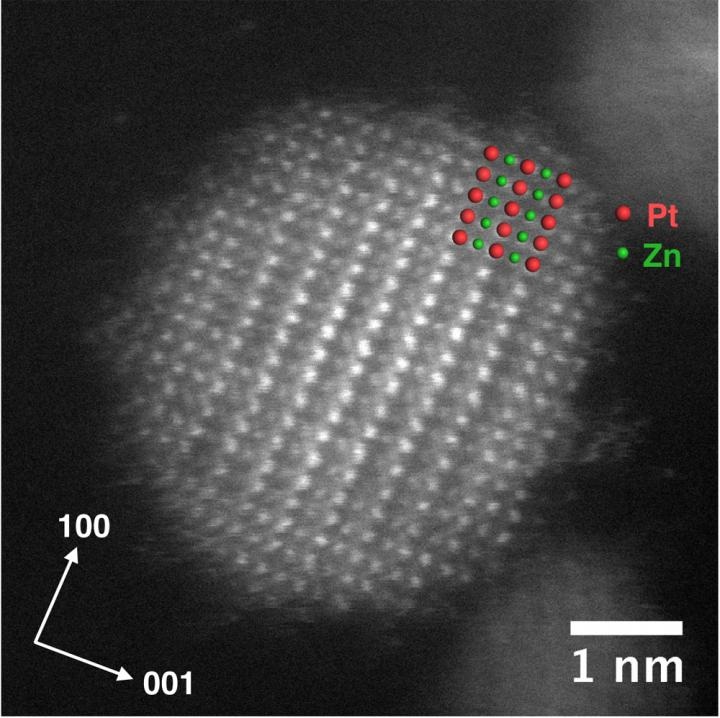May 10 2017
 This high-resolution image shows the distribution of platinum and zinc atoms in a PtZn intermetallic nanoparticle. Credit: Ames Laboratory, U.S. Department of Energy
This high-resolution image shows the distribution of platinum and zinc atoms in a PtZn intermetallic nanoparticle. Credit: Ames Laboratory, U.S. Department of Energy
A method for producing more efficient, smaller intermetallic nanoparticles, for fuel cell applications, has been discovered by scientists at Ames Laboratory. This new method also uses less of the expensive precious metal platinum.
The researchers succeeded in discovering this method after overcoming some of the technical challenges they encountered in the fabrication of the platinum-zinc nanoparticles with an ordered lattice structure, which work best at the small sizes in which the chemically reactive surface area is at the peak in proportion to the particle volume.
That surface-to-volume ratio is important in getting the most out of an intermetallic nanoparticle. The smaller the particle, the more surface there is, and more surface area increases the catalytic activity.
Wenyu Huang, Assistant Professor of Chemistry, Iowa State University
However, the goal of attaining a small size is frequently defeated by the high temperature of the annealing process essential to produce intermetallic nanoparticles
High-temperature annealing can cause the particles to aggregate or clump, and produces larger sizes of particles that have less available surface and aren’t as reactive. So, just the steps necessary to produce them can defeat their ultimate chemical performance.
Wenyu Huang, Assistant Professor of Chemistry, Iowa State University
Huang’s research group prevented the occurrence of aggregation during the heating process by initially using carbon nanotubes as a support for the PtZn nanoparticles, and then coating them with a sacrificial mesoporous silica shell for the high-temperature annealing to produce the intermetallic structures. The silica shell is then removed by a chemical etching process.
The final product of uniform 3.2 nm platinum-zinc particles yielded twice the catalytic activity per surface site. In addition to this, that surface area experienced ten times the catalytic activity of bigger particles comprising of the same amount of platinum.
A new Titan scanning electron microscope at Ames Laboratory’s Sensitive Instrument Facility was partially responsible for this discovery because of capabilities, and was jointly funded by the Department of Energy and Iowa State University.
Being able to see the distributions of the material at atomic level with our new microscope has made an enormous positive impact on the Laboratory’s capabilities to fine-tune materials. It’s a much more immediate process, being able to collaborate directly with the fabrication scientists in-house. Based on the results and suggestions we provide, they can improve the material, we can characterize it yet again, and the discovery cycle is much faster.
Lin Zhou, Associate Scientist and Instrument Lead, Sensitive Instrument Facility
Further discussion of this research is available in a paper, “Sub-4 nm PtZn Intermetallic Nanoparticles for Enhanced Mass and Specific Activities in Catalytic Electrooxidation Reaction”, authored by Zhiyuan Qi, Chaoxian Xiao, Cong Liu, Tian-Wei Goh, Lin Zhou, Raghu Maligal-Ganesh, Yuchen Pei, Xinle Li, Larry A. Curtiss, and Wenyu Huang and published in the Journal of the American Chemical Society.
The National Science Foundation, Iowa State University, Ames Laboratory Directed Research and Development (LDRD) funds, and the U.S. Department of Energy’s Office of Science funded this work. The Laboratory Computing Resource Center and the Center for Nanoscale Materials supported the computational work at Argonne National Laboratory.
Ames Laboratory is a U.S. Department of Energy Office of Science national laboratory operated by Iowa State University. Ames Laboratory develops innovative energy solutions, technologies and materials. The laboratory uses its unique capabilities, interdisciplinary collaborations and expertise to solve global problems.
DOE’s Office of Science is the single largest supporter of basic research in the physical sciences in the United States, and focuses on addressing some of the most pressing challenges that currently exist.